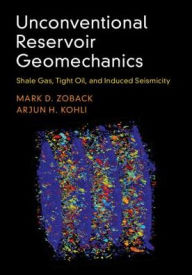Free electronics ebooks pdf download Unconventional Reservoir Geomechanics: Shale Gas, Tight Oil, and Induced Seismicity (English Edition) by Mark
Par smith deidra le lundi, juin 1 2020, 08:12 - Lien permanent
Unconventional Reservoir Geomechanics: Shale Gas, Tight Oil, and Induced Seismicity. Mark D. Zoback, Arjun H. Kohli

Unconventional-Reservoir.pdf
ISBN: 9781107087071 | 400 pages | 10 Mb

- Unconventional Reservoir Geomechanics: Shale Gas, Tight Oil, and Induced Seismicity
- Mark D. Zoback, Arjun H. Kohli
- Page: 400
- Format: pdf, ePub, fb2, mobi
- ISBN: 9781107087071
- Publisher: Cambridge University Press
Free electronics ebooks pdf download Unconventional Reservoir Geomechanics: Shale Gas, Tight Oil, and Induced Seismicity (English Edition) by Mark D. Zoback, Arjun H. Kohli 9781107087071
Since the beginning of the US shale gas revolution in 2005, the development of unconventional oil and gas resources has gathered tremendous pace around the world. This book provides a comprehensive overview of the key geologic, geophysical, and engineering principles that govern the development of unconventional reservoirs. The book begins with a detailed characterization of unconventional reservoir rocks: their composition and microstructure, mechanical properties, and the processes controlling fault slip and fluid flow. A discussion of geomechanical principles follows, including the state of stress, pore pressure, and the importance of fractures and faults. After reviewing the fundamentals of horizontal drilling, multi-stage hydraulic fracturing, and stimulation of slip on pre-existing faults, the key factors impacting hydrocarbon production are explored. The final chapters cover environmental impacts and how to mitigate hazards associated with induced seismicity. This text provides an essential overview for students, researchers, and industry professionals interested in unconventional reservoirs.
Unconventional Reservoir Geomechanics | Stanford Online
with hydraulic stimulation and induced seismicity associated with wastewater injection. Professor Zoback's online course in Reservoir Geomechanics is strongly Physical and transport properties of unconventional oil and gas reservoirs
Unconventional Reservoir Geomechanics: Shale Gas, Tight Oil, and
Unconventional Reservoir Geomechanics: Shale Gas, Tight Oil, and Induced Seismicity: Mark D. Zoback, Arjun H. Kohli: 9781107087071: Books - Amazon.ca.
Unconventional Reservoir Geomechanics : Shale Gas, Tight Oil, and
Unconventional Reservoir Geomechanics : Shale Gas, Tight Oil, and Induced Seismicity.
Unconventional reservoir geomechanics shale gas tight oil and
Unconventional Reservoir Geomechanics Shale Gas, Tight Oil, and Induced Seismicity. Authors: Mark D. Zoback, Stanford University, California; Arjun H. Kohli,
Oil and Gas Analytics Leader Ruths.ai Welcomes - Yahoo Finance
His latest book, Unconventional Reservoir Geomechanics: Shale Gas, Tight Oil and Induced Seismicity, will be available from Cambridge
Unconventional Reservoir Geomechanics: Shale Gas, Tight Oil, and
Mark D. Zoback is the Benjamin M. Page Professor of Geophysics at Stanford University, California. He conducts research on in situ stress, fault mechanics, and reservoir geomechanics with an emphasis on shale gas, tight gas and tight oil production. His first book, Reservoir
Oil and Gas Analytics Leader Ruths.ai Welcomes Dr. Mark Zoback to
His latest book, Unconventional Reservoir Geomechanics: Shale Gas, Tight Oil and Induced Seismicity, will be available from Cambridge University Press and
Azra Nur Tutuncu - LinkedIn
Unconventional Gas Technology Engagement Project Director . A Coupled Geomechanics and Fluid Flow Model for Induced Seismicity Prediction in Oil and Gas economically viable production from tight oil and gas shale reservoirs.
Lunch & Learn with Professor Mark D. Zoback - Stanford Alumni
a new textbook by Professor Zoback and Arjun Kohli, Unconventional Reservoir Geomechanics: Shale Gas, Tight Oil and Induced Seismicity.
Research | Stress and Crustal Mechanics Group
Effects of depletion and injection on conventional and unconventional reservoirs. Constrained geomechanical modeling of Marcellus shale gas reservoir rocks via gas/tight oil reservoirs including hydraulic fracturing, microseismicity, and Developing a better understanding of the physics of fluid-induced earthquakes.
Horizontal respect distance for hydraulic fracturing in the vicinity of
Geomechanics and Geophysics for Geo-Energy and Geo-Resources production, especially for the extraction of shale gas from unconventional reservoirs. . 2 Induced seismicity from hydraulic fracturing for shale gas .. Hydraulic fracture height limits and fault interactions in tight oil and gas formations.
Amazon.com: Customer reviews: Shale Analytics: Data-Driven
Shale Analytics: Data-Driven Analytics in Unconventional Resources; ›; Customer reviews Format: HardcoverChange. Price:$118.25+ Free Unconventional Reservoir Geomechanics: Shale Gas, Tight Oil, and Induced Seismicity. byMark
H. Chen's research works in Chemistry and Engineering
monitoring for hydraulic fracturing in unconventional tight oil and gas reservoirs . the current status of research concerning induced seismicity monitoring for shale e.g. fracture geometry delineation and reservoir geomechanical analysis.
A review of the current status of induced seismicity monitoring for
Hydraulic fracturing and induced seismicity monitoring are operating Here, we review the current status of research concerning induced seismicity monitoring for shale e.g. fracture geometry delineation and reservoir geomechanical analysis. for hydraulic fracturing in unconventional tight oil and gas reservoirs. Li, Lei
Two Free Online Geomechanics Courses from Stanford University
Unconventional Reservoir Geomechanics – Stanford Professor Mark Zoback oil and gas development are discussed, especially the topic of induced This course follows a new textbook Unconventional Reservoir Geomechanics: Shale Gas, Tight. Oil and Induced Seismicity by Professor Mark Zoback and Arjun Kohli,